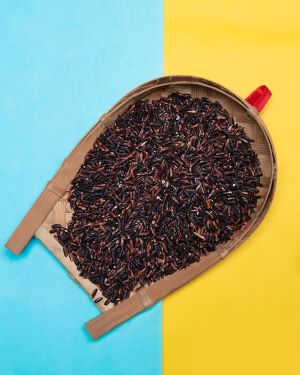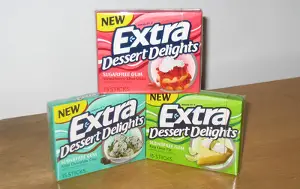
Most of us spoil our dogs something rotten, don’t we?
If we treat our dogs like VIPs or royalty why don’t we go the whole hog and give them food fit for kings- and queens?
In today’s article, I’m going to be looking at one such food.
Black rice is a food that has been eaten for thousands of years particularly in Asia and at one stage it was prized so highly that only Chinese royalty could eat it.
And for those of you who have been a bit put off feeding black rice to your dog because of the colour then don’t worry.
The dark colour doesn’t indicate a nasty toxin that will kill your dog on contact, instead it is a very powerful nutrient.
So, if nothing is too good for your dog (no matter what the price) let’s find out if black rice lives up to the hype…
What is black rice?
Black rice is actually a form of wild rice.
It is so named because when it is uncooked it is black and after cooking it will soten to a dark purple colour.
Black rice is also known as “forbidden rice” or “Emperor’s rice” in Ancient China because only the very wealthy could afford to eat it or because it was so rare that only royalty could eat it.
To some Italians it is called “the rice of Venus”.
Little has changed since then.
A quick search at walmart.com reveals that black rice can be as much as nine times more expensive than long grain white rice
This rice is very popular in southern Asia and Thailand, The Philippines and Indonesia all have their own varieties of black rice.
It is much starchier and more sticky than the white rice that we are used to eating with our curries and in this way it is more like our pudding rice.
And in Asia it is used almost exclusively in desserts and puddings.
Anthocyanin: the power of dark purple
As I mentioned in the introduction, some of you might be slightly wary of the vibrant colour.
But there is no need to be.
Without a doubt, black rice is a thing of beauty but how nutritious is it?
The answer to that is “very.”
One of its superpowers is that it contains the plant compound anthocyanin.
Which is why its colour is so striking.
Anthocyanins can have strong antioxidant and anti-inflammatory effect.
And that could benefit your dog’s heart amongst other things.
Anthocyanins are also found in abundance in another superfood- blueberries.
Which, surprise surprise, are also dark purple…
What other nutrition does black rice provide?
Leaving purple behind for the moment, I think that a very important question is how black rice “stacks up” against other rice.
I mean it is one thing to look beautiful, another thing to cost a bomb but how nutritious is it?
Well to answer that question in a bit more depth, I have created a chart which you can see below.
| 100g serving | Black Rice | Wild rice | Brown rice | White rice |
| Calories | 353 | 357 | 367 | 360 |
| Fat | 2 g | 1.1 g | 3.2 g | .6 g |
| Carbohydrate | 76 g | 75 g | 76 g | 79 g |
| Fiber | 9.8 g | 6.2 g | 3.6 g | 0 |
| Protein | 7.8 g | 15 g | 7.5 g | 6.6 g |
| Iron | .98 mg | 1.96 mg | 1.29 mg | .8 mg |
| Potassium | 157 mg | 427 mg | 250 mg | 86 mg |
And this chart compares the most important nutritional values of black, wild, brown and white rice per 100 g serving.
And in the big scheme of things there is little difference between all of these varieties.
Which is perhaps no surprise because they are all rice!
In the chart I have highlighted in green what I consider to be the best value within a category.
So for calories I have highlighted 353 in the black rice column because it has the lowest number of calories.
But the differences are very small.
The other nutrition that black rice “excels” at is the amount of fiber that it contains.
And at 9.8 g it is almost 10% fiber- which is significantly more than any of the other rices.
And that is a very impressive figure for any food.
Much higher than pumpkin or sweet potato– which are both used as a home remedy for diarrhea because they are foods that are high in fiber!
But I digress…
Protein wise black rice is about average compared to other rice with about 7.8 g.
In terms of iron and potassium the values between all the varieties of rice vary significantly.
However, I would say that the amount in black rice is about average.
So, you are flush with cash and you fancy spoiling your dog with a food that both looks great and is full of fiber.
Is black rice unhealthy in any way?
It is easy to get carried away with a product that is as beautiful as black rice and start exaggerating the effect that it can have on your dog.
Black rice isn’t unhealthy as such but there is one thing to bear in mind.
76 g in every 100 g of black rice contains carbohydrates- well 66 g if you subtract the 10 g of fiber…
Now I don’t want to go completely over the top and start screaming at the top of my lungs about how evil carbohydrates are, but it is something to be aware of.
Don’t be blindsided by all of the sexy messages about black rice and forget the basics.
Carbohydrates aren’t a necessary part of any dog’s diet.
Dogs need protein and fat from their food but not carbohydrates.
And if a dog eats too many carbs, they will become overweight.
That is it- my health rant is over.
Let me get back to some more positive messages by looking at the best way to prepare black rice for your dog.
What is the best way of preparing black rice for dogs?
Well the good news is that dogs should eat black rice in exactly the same way as people.
Cook it in boiling or simmering water for about 35 minutes.
The texture you are aiming for is tender but chewy- similar to brown rice or wild rice.
What does black rice taste like?
Black rice has a nutty flavour which comes because it is a whole grain rice with the bran left on.
In that way it is very similar to brown rice.
How much black rice should I feed my dog?
Ah this old chestnut…
I would say that this depends on what else your dog is eating but bearing in mind how much it costs, my answer would be as little as possible!
And like any other food that you are tempted to feed your dog (outside of its main diet) you are really looking at giving your dog a few tablespoons every now and then.
As I have already mentioned its high protein content would make it an excellent addition to your arsenal of diarrhea home remedies but for the price.
If I was you, I would stick to pumpkin…
Other foods rich in anthocyanin
Perhaps, I’m stating the obvious by saying that wild rice isn’t the only anthocyanin rich food.
There are plenty out there to choose from.
In fact if you think of a fruit or vegetable that is dark purple then it probably contains anthocyanin and will have many of the same benefits.
The list of fruits includes blueberries and blackberries.
You might be cynical about getting your dog to eat any piece of fruit.
To be honest, I have never tried to feed blueberries to my dogs but I know for a fact that they love blackberries.
When I go blackberry picking, my dogs join in munching on the blackberries that are on the lower branches.
Although small blueberries would be an excellent reward to use with your dog when you are doing any training.
The fact that they are small means that your dog isn’t being fed huge quantities of treats during training.
And blackberries are firm enough to stay in your pocket without being squashed.
The same cannot be said for blackberries…
In terms of vegetables, aubergines and red cabbage contain high levels of anthocyanins.
And good luck to any dog owner that is can get their dog to eat aubergine!
After discussing other foods that contain lots of anthocyanin in my final section of this article, I want to look at other nutritious grains that you might want to feed to your dog as an occasional treat.
What other “grains” are nutritious for dogs?
The choice of nutritious grains that you can feed your dog is almost unlimited- and therein lies the problem.
Just how do you choose?
One way that I have stumbled across is a list of grains which are ordered in terms of how nutritious they are.
And funnily enough, the most nutritious grain is one of my favourites: porridge oats.
In a past life I used them extensively in a homemade dog food recipe that I made.
They cost about the same as white rice, are prepared in a similar way and are packed with nutrients.
Per 100g serving about 17% is protein, 66% carbohydrates, 11% fiber and 6% fat.
In second place is a much more obscure grain which up until now I knew little about: Amaranth.
In appearance it looks a lot like quinoa or couscous.
And nutrient wise it is high in protein, fiber and essential minerals such as iron and magnesium.
However, its rich nutritional content does come with a price.
It is four or five times the price of quinoa!






